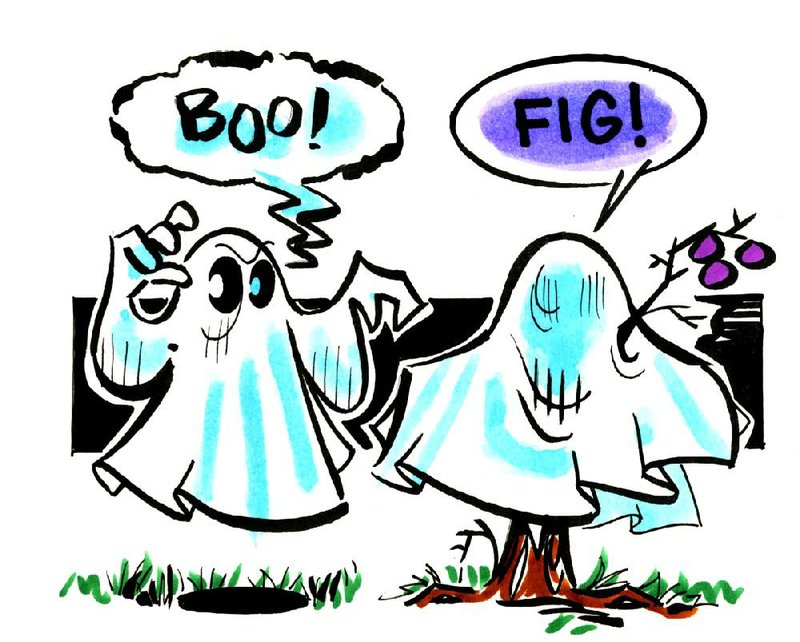Q Three summers ago I planted two small fig bushes. I covered them with sheets the first winter, and last summer I had a small crop. I did not cover them this past winter as they were about 8 feet tall and bushy. I thought that the two consecutive days we had where the temperatures did not get above 10 degrees did them in as the canes did not survive. To my surprise, both have sprouted from the roots and even now have some fruit on them. As of this writing they are taller than before and look better than ever. My question is, what can I do to help them get through this next winter? I thought of cutting them back to a reasonable height and again covering them with something.
A When I started work in 1980, we called fig trees "fig bushes" because they froze to the ground almost every year. They resprouted during the season and did have some figs, as these trees bear fruit on new growth. Before last winter, they had been skating through our winters undamaged, and we have some pretty large fig trees now dotting the landscapes. Temperatures below 15 degrees can take a toll. Make sure there is ample water in the ground before low temperatures. Covering can give you a couple of degrees of protection, but a sheet is not much help. In the early cold years, we used to recommend building a wire cage around the trunk and dumping leaves in it for extra protection. The leaves were not packed in, but just a loose fill. I know some very industrious gardeners who built small houses around their figs, but I think that is overkill. Pay attention to the weather this winter. If the bushes are small enough, you could put protection around them when it is cold. Regardless, keep them mulched at the base, and they should always come back from the roots.
Q I have a crape myrtle that has grown so tall it is covering the spot where I would like to hang our large outdoor Christmas wreath. I did cut it back to the main stalk this spring, and I would like to cut it back again before hanging the wreath for the holiday season. If I can cut it back without harming the plant, when should I do this and how far back should I do this? Or do you advise against cutting it back at all before the holidays?
A The correct time to prune a crape myrtle, if needed, is late February. If you simply need to remove a branch that interferes with your Christmas decorations, cut that branch back when you decorate, but do the bulk of your pruning in February. Pruning in the fall or early winter leaves the plant more open and exposed to winter weather.
Q We have green and purple sweet potato vines in a pot. I bought a small mum plant to replace the scraggly coleus in the middle. When I went to dig into the center of the pot to anchor the mum plant, I dug up a large (softball size) "thing." Its skin is purple, similar to a beet, the flesh is almost white. Is it a relative of our usual sweet potato? Is it edible?
A The ornamental sweet potato can produce a sweet potato -- a few have been quite large. While technically it is edible, it doesn't taste very good. That is why it is sold as an ornamental and not an edible. You can save the fruits to replant next spring.
Q We live in Hot Springs Village. Three of these cute things [the reader sent a photo] were eating one of many of our potted plants on the deck. Literally in just a few hours, they'd almost devoured the plant you see pictured. Can you tell us anything about it? We've never seen it before and no more since removing the three we found. We are curious about these creatures.
A You have a sphinx caterpillar. This particular one is the Tersa sphinx. The adult moth is brown and feeds on the nectar of honeysuckle and four o'clocks. The larvae like catalpa, pentas and firebush (Hamelia patens), but I am sure they would eat a few more species. The spots on their body resemble eyes to scare away predators. Larvae of this family of moths are called hornworms because of the horn on the back of the body, and they are voracious feeders -- tomato hornworms can annihilate a plant seemingly overnight. Yours is quite showy. Thanks for sharing.
Janet B. Carson is a horticulture specialist for the University of Arkansas Cooperative Extension Service. Write to her at 2301 S. University Ave., Little Rock, Ark. 72204 or email her at
jcarson@arkansasonline.com
HomeStyle on 09/27/2014
